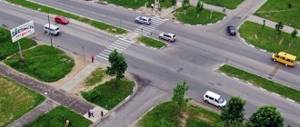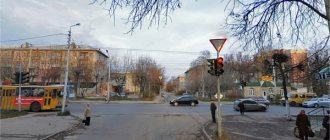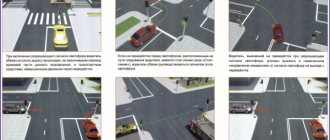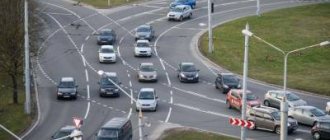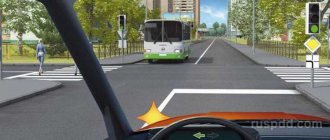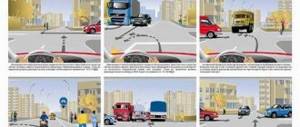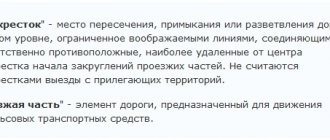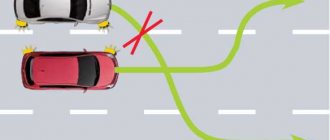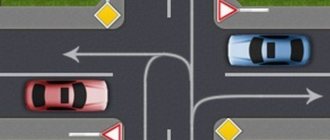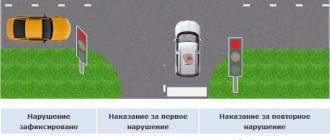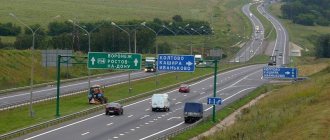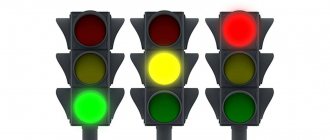Uncontrolled intersection: what is it?
The traffic rules clearly state that an unregulated intersection has rules of passage and definition. In general, any intersection is an intersection of roads in one plane, and the word “unregulated” means that there is neither a traffic light nor a traffic controller.
Many novice drivers think that driving through an uncontrolled intersection couldn’t be easier, but statistics say completely the opposite. It was during such maneuvers that the largest percentage of collisions was recorded. But everything is very simple: one did not want to let the other pass or overestimated his strength, and the second followed the principle or simply did not notice the obstacle.
It is also interesting that an intersection is not necessarily a four-way intersection of roads. Intersections can also be T-shaped, in the form of a triangle, circle or star.
General requirements for drivers at uncontrolled intersections
Traffic inspectors never tire of repeating to all drivers, even those who already have a lot of driving experience, that in order to safely drive through this type of intersection, you need to be vigilant, as well as respect for all road users, and give way to pedestrians and those cars that have priority.
A high-risk location is an unregulated intersection. The rules for traveling on it will be discussed below, but among them there are those that need to be given special attention.
One of the basic rules is maintaining distance. One car must be at least 50 meters away from the other. This distance is considered the safest. It will allow any driver, even an inexperienced one, to react in time to the current situation and, if necessary, brake.
In addition, when turning, the car must occupy the side in which it is going to turn.
Unregulated intersection: rules of passage, determination of the type of intersection
Before considering this issue, it should be noted that it does not matter at all what shape the intersection is. First of all, you need to understand what type it is.
Intersections are divided by type into regulated and unregulated. If everything is clear with the regulated, then the unregulated is divided into two more types: equivalent and unequal.
An unequal intersection always has one main road and one secondary road. For an equivalent, all roads have the same priority.
In a driving school, instructors must clearly explain to students what an uncontrolled intersection is. The rules for driving on it are learned by heart. This is the only way a future driver can pass it safely.
Driving through a controlled intersection
It should be noted that the rules for driving through controlled and uncontrolled intersections are very different. Of course, a controlled intersection is much easier to negotiate. The traffic sequence is controlled by a traffic light; if there is none, this function can be performed by a traffic controller.
According to the traffic rules, if the intersection is controlled by a traffic controller and the traffic light is working, then you should rely on the instructions of the traffic controller. In other cases, it is necessary to follow the traffic light sequence.
There is one more rule. When turning left, a driver at a signalized intersection must give way to all traffic participants who are turning right or driving straight.
Lesson 11. Driving through intersections.
There are two types of intersections.
- Controlled intersections.
- Unregulated intersections.
Signs.
Controlled intersections.
- Traffic is regulated by a traffic light.
- The traffic is regulated by a traffic controller.
Unregulated intersections.
- There are no traffic lights or traffic controllers.
- The traffic light is not working.
- The traffic light operates in yellow flashing mode.
It is important to learn how to determine the type of intersection, since the rules for driving through signalized intersections and uncontrolled intersections differ from each other. When solving tickets, you will encounter intersections with traffic lights and priority signs installed in front of them. It is important to understand that these are mutually exclusive items.
It is impossible to be guided by both traffic lights and priority signs at the same time. In this case the rule applies.
If the traffic light is operating in the main mode, then you need to be guided by the traffic light. If the traffic light is turned off or operates in yellow flashing mode, then you need to be guided by priority signs.
You see a working traffic light and priority signs. These are things that exclude each other. You cannot be guided by both at the same time. In this case, we need to be guided by the traffic lights and do not pay attention to the signs. We drive to the middle of the intersection, give way to the bus and pedestrians and finish the maneuver.
If the traffic light did not work or worked in the yellow flashing signal mode, then we, being on the main road, would have an advantage over the bus.
General rules for controlled and unregulated intersections.
1. When turning right or left at any intersection, you must give way to pedestrians crossing the roadway you are turning onto, as well as to cyclists crossing it on a bicycle path. 2. It is prohibited to enter an intersection if there is a traffic jam behind it that will force you to stop, creating interference with other vehicles.
(Tickets 6/14, 7/14, 8/14, 9/13, 17/13).
Unregulated unequal intersection: how to determine the main road
The traffic rules clearly indicate the signs of the main road:
- The motorway will always be the main road.
- Any road with a hard surface, be it asphalt, concrete surface or paving stones, is considered the main road.
- The main road is marked with appropriate road signs 2.1.
These remarks will only apply if the intersection is unregulated and necessarily unequal. Other rules apply to equivalent ones.
But it is not enough for the driver to simply study three points. There are also unspoken rules for driving through unregulated unequal intersections:
- a driver approaching an unregulated unequal intersection must slow down;
- after he is convinced that there is no interference, he can begin to perform the maneuver;
- It is strictly prohibited to brake sharply before an uncontrolled intersection.
Rules for driving through unregulated intersections.
There are only three rules, and they are applied alternately, depending on seniority.
1. The one who approached the intersection along the main road has the advantage;
2. The advantage of the tram;
3. Interference on the right.
Rule 1. For intersections of unequal roads.
Let us recall the rules that determine the primacy of one road in relation to another.
The main road is a road marked with signs 2.1 “Main Road”, 2.3.1 – 2.3.7 “Intersection (junction) with a secondary road”, 5.1 “Highway”. If there are no signs, then the main road is considered to be one with any hard surface compared to the dirt road.
When driving through intersections of unequal roads, the vehicle that was on the main road before entering the intersection has priority over those who arrived on a secondary road.
The further direction of movement of vehicles does not matter. This rule applies to absolutely everyone.
A tram located on a secondary road gives way to a “non-tram” located on the main road.
(Tickets 11/15, 13/15, 22/15, 29/15).
Rule 2. Advantage of the tram. For roads of equal importance.
If on roads of equal importance there are a tram and a “non-tram”, then the tram has priority in traffic, regardless of the direction of its movement.
(Tickets 22/14, 23/14, 29/14, 36/14, 37/15, 38/14, 39/14).
Rule 3. For vehicles of equal importance located on roads of equal importance.
3.1. When turning left or making a U-turn, the driver must give way to a vehicle moving from the opposite direction straight or to the right. (Ticket 1/14, 18/15).
3.2. When driving through an intersection, you must give way to a vehicle approaching from the right. (Tickets 2/14, 11/14, 12/14, 14/14, 16/14, 18/14, 20/14, 26/14, 27/14, 28/14, 35/14, 37/14) .
What are equivalent uncontrolled intersections?
An equivalent intersection may also be unregulated. The rules for traveling on it differ from those established on the unequal one. First of all, at this type of intersection there are no main or secondary roads. The driver can also understand that there is an unregulated intersection in front of him using the installed sign 1.6. However, it is not always available.
It should be noted that when approaching the intersection of equivalent roads, the driver must be especially careful. The fact is that it is at such intersections that accidents most often occur, because there is no exact indication of where the main road is located.
What could be an insoluble situation at a crossroads?
Rules for traveling through railway crossings
A traffic situation may arise at an intersection from which it is impossible to find a way out within the framework of current traffic rules.
It consists in the fact that cars approach an equivalent intersection simultaneously from all directions. Moreover, at each of the four entrances there is at least one car whose driver wants to drive straight, turn left or turn around.
The essence of this insoluble situation is that each driver must give way to the other car (which is on his right). White is inferior to orange, orange is inferior to blue, blue is inferior to green, green is inferior to white. Therefore, they are all forced to stand and cannot pass.
A way out of this situation can be found as follows. All vehicles approaching from one direction must turn right. In this case, the remaining cars will gradually be able to move apart.
However, if such a situation arises in practice, I do not recommend that you show off your knowledge and be the first to turn right. Let other drivers do it better.
This is due, firstly, to the fact that when approaching the intersection, you have already taken the correct position on the roadway, corresponding to the intended exit direction. Therefore, turning to the right from such a position can lead to a violation of the rules or an accident.
Secondly, the driver has no information about where the right road will lead him and whether he will be able to turn around there. Therefore, it is better to wait until the situation resolves itself, remaining in your place in front of the intersection.
Well, in the next article we will talk about intersections with tram tracks.
Good luck on the roads!
The intersection of equivalent roads can often involve situations the exit from which will not comply with traffic rules.
Such a case can occur when cars arrive at the same time and at the same time on each of the 4 sides there is at least one that is going to go straight or make a U-turn. The intractability of the situation lies in the fact that each driver is obliged to give way to another car located on his right side, because of this, everyone else remains at the intersection and is not able to pass.
But the following way out can be found - all transport that comes from one direction can turn right, and other cars will move away over time. But still, if this situation arises, then if you are not in a hurry, then the best advice would be not to make the first turn to the right, but to wait, so as not to risk it again.
This is so because you yourself, having approached the intersection, have already taken a certain position from which you are going to exit, and if you start turning right, this can often be like a violation of the rules. It also often happens that when you turn right, you end up in an unknown place where you can’t even turn around normally, so the best option would be to take your time, no matter what the load, and then drive through it calmly.
Rules for driving through unregulated intersections
As already mentioned, at this type of intersection the driver must be attentive and exercise caution. If the intersection, in the opinion of inspectors, is particularly difficult, then in some cases a 5.33 marking, that is, a stop line, may be applied to it.
Of course, there are rules for driving through uncontrolled intersections of equivalent roads, but there are not many of them. To be more precise, there is only one thing.
The driver, having approached an equivalent intersection, must first slow down, or better yet, when the flow of cars is especially large, stop. Only then will he be able to drive through it safely. After the driver has stopped, he must make sure that there are no obstacles to the passage. The obstacle at an equivalent intersection is always on the right side.
In addition, it is worth noting that if at an equivalent intersection the driver decides to turn left, then he is obliged to give way to pedestrians and those traffic participants who are moving straight turn right.
Regulated equivalent intersection
Rules for driving through intersections.
Driving through controlled intersections The concept of “regulated” indirectly indicates that the traffic order rules at this intersection are determined in two ways:
- through a traffic light;
- through the regulator.
It cannot be regulated by signs, because otherwise the roads will no longer be considered equal and priorities will be set. There are a number of important rules regarding movement at these intersections:
- If the regulating device, the traffic light, is working properly, all drivers must follow the basic rules. This applies to all intersections.
- If there is a traffic controller at the intersection, drivers are required to follow his commands. The fact is that sometimes it is necessary to adjust the movement manually even when the traffic light is working. In these cases, the traffic controller will be in charge of the road.
- If you are driving at a red traffic light with an additional green arrow, you need to give way to all cars that are on the same path as yours.
It is sometimes useful to re-read the traffic rules; sometimes it helps a lot in difficult situations. Driving through an uncontrolled intersection of equal roads is one such case. In any case, always be careful and extremely polite.
As the traffic rules state, today there are several ways to regulate intersections, these are:
- Traffic light;
- Traffic signs;
- A traffic police and traffic police officer, that is, a traffic controller;
In addition to regulating intersections with the intervention of third parties or special equipment (signs or traffic lights), there are additional rules that, in the absence of all components, can resolve the dispute.
Today it is:
- Uneven road surfaces
. The surface of the road determines the role of traffic at the intersection along it. That is, if the intersection is the intersection of a gravel and asphalt surface. The road with an asphalt surface is considered the main one. - Right hand rule
. If the traffic of the intersection is not regulated in any way and the road surface is equal, then we are guided by the “obstacle on the right.” That is, all those vehicles that are on the right have a primary role, which means that the driver on the left gives way.
According to the traffic rules, an intersection where the traffic order is not regulated by traffic lights, traffic police officers, that is, a traffic controller, signs, as well as an intersection where the roads have the same surface, is an unregulated intersection of equivalent roads.
From here we get that an equivalent road is a section of the road that is not regulated, either by signs or devices, where there is no traffic controller. At the same time, the road coverage is equal. A crossroads of equivalent roads is an intersection of streets where the directions are equal in meaning.
Then, as the traffic rules say, the driver must follow the right-hand rule. That is, let everyone who is on the right side of the intersection pass. In turn, the driver who moves along the intersection on the right side has the main road and should not allow vehicles on his left to pass.
What is a T-junction?
A T-junction is an intersection that appears to be the intersection of two roads, but one road appears to flow into the other and is most often a perpendicular line between the two lines. In drawings it is usually depicted as two lines with a right angle.
Interestingly, a T-junction, although slightly different from a regular road crossing, has the same clearance requirements.
This type of intersection can also be multi-valued and unequal. It is usually easier for drivers to overcome it due to the fact that there are only three directions of movement here.
There are rules for driving through an uncontrolled T-junction. However, they are no different from other intersections. If it is equal, then the driver must give way to a vehicle passing on the right, and if not, he must follow the rules defining the main and secondary roads.
If a T-junction turns into a one-way road, then you can only turn around or turn left (if driving on the right).
Uncontrolled roundabouts
Another type of intersection that is especially difficult for novice drivers is called a roundabout. There are never traffic lights, so it is always an unregulated intersection. The rules for traveling there are special.
Roundabouts, like ordinary intersections, can be equal or unequal. If the roundabout is of the second type, then the driver must rely on the appropriate signs. If the intersection with a roundabout is equivalent, then the main road is always near those cars that are already on the circle.
When entering a roundabout, the driver must show the right turn signal. The same turn signal should also light up if the vehicle is leaving a roundabout.
The driver can enter the roundabout from any lane, but exit only from the right lane. You also need to watch out for blind spots, because when the road bends, some cars cannot be seen. This is especially true for drivers who have recently received their license.
Rules for driving at controlled intersections.
Before starting to study the rules for crossing intersections, it is necessary to introduce the concept of “vehicle disparity.” All vehicles are divided into two groups.
- Trams.
- All other (trackless) vehicles are “not trams” .
In most cases, when passing intersections, trams have priority over non-trams. If vehicles belong to the same group (trams or “non-trams”), then this is a transport of equal importance.
Rule 1. For vehicles of equal value.
Look at the picture. A car collision can happen if we go left or make a U-turn, and the oncoming car goes straight or right. In other cases, the motion trajectories will not intersect. Therefore there is a rule:
When turning left or making a U-turn at a green traffic light, you must give way to a vehicle moving towards us straight or to the right.
Proceed as follows. When the signal turns green, drive to the middle of the intersection and stop so as not to interfere with oncoming traffic moving straight or to the right. Having given way to oncoming traffic, we are obliged to leave the intersection regardless of traffic lights and the actions of other drivers. (Tickets 2/13, 7/13, 21/13, 22/13, 30/13, 32/13).
Rule 2. Advantage of the tram.
If the traffic light or traffic controller signals allow the movement of a tram and a “non-tram” at the same time, then the tram has priority, regardless of the direction of its movement. (Tickets 6/13, 13/13, 15/13, 16/13, 24/13, 28/13, 33/13, 34/13, 35/13, 40/13). Rule 2 has an exception (see rule 3).
Rule 3. For all vehicles.
Look at the picture. The main traffic light is red, therefore, the traffic lights in other directions are green. However, our traffic light has a green arrow on, allowing a right turn.
Trams are only allowed to move to the right (arrow), cars - in any direction (main green). A collision may occur. Therefore the rule:
When driving in the direction of the arrow turned on in the additional section of the traffic light simultaneously with the red signal of the main section, you must give way to vehicles moving from other directions. (Equivalent to entering the main road).
This rule applies to absolutely everyone. Even a tram, if it moves to a switch that is turned on at the same time as a red traffic light, must give way to “non-trams.” (Tickets 1/13, 19/13, 26/13).
Rule 4. A driver who enters an intersection when there is a permission signal is obliged to leave it, regardless of the signals at the exit from the intersection.
This is a general rule. However, there are large intersections (squares) that cannot be crossed at once. At such intersections, “stop lines” may be placed on the path of traffic, and more often, “stop line” signs 6.16 are installed. In this case, you must follow the rule:
If, after entering the intersection, there are stop lines or signs 6.16 “Stop Line” on your path, you must follow each traffic light in front of you.
If the traffic light in front of you has a red signal on, then you must stop in front of the stop line and wait for the green signal. (Ticket 29/13).
Rule 5. After turning on the green signal, you can start moving through the intersection, only giving way to vehicles that did not manage to leave the intersection and to pedestrians who did not complete the crossing.
(Tickets 10/13, 14/13).
Unregulated intersection and pedestrians
Absolutely all drivers must follow traffic rules and caution, especially when it comes to pedestrians. If we are talking about ordinary pedestrian crossings, everything is simpler. You need to brake in advance, you need to be vigilant, especially if a child has entered the crossing.
Also, the driver must be as careful as possible with those pedestrians who cross the road in the wrong place. Of course, in the event of an accident he will not be to blame, but human life is much more valuable than principles. In order for the driver to be able to quickly respond to danger in the form of an intruder at any time, it is necessary to constantly observe the speed limit.
It is worth noting that when driving through an uncontrolled intersection, the driver must remember one more rule regarding pedestrians. The fact is that when turning right or left, any participant in the movement is obliged to stop and let pedestrians who are about to cross the road pass, even if there is no specialized crossing there.
Driving schoolhome traffic rules online
We have launched free distance learning on Youtube. Subscribe to our channel and watch video lectures.
First of all, it is necessary to understand that the intersection of equivalent roads is necessarily not regulated
crossroads There are no traffic controllers or traffic lights here. Or there are traffic lights, but they do not work or are switched to yellow flashing mode:
Rules.
Section 13. Clause 13.3. If there is a flashing yellow signal, non-working traffic lights or the absence of a traffic controller, the intersection is considered unregulated .
A yellow flashing signal informs drivers that the intersection has become unregulated.
There are no priority signs; both paved roads are an intersection of equivalent roads.
There are no traffic lights here at all, and there are no priority signs - this is an intersection of equivalent roads.
At such intersections, drivers must set their own driving order, guided by the general principle of “interference on the right”:
Rules. Section 13. Clause 13.11
.
At an intersection of equivalent roads, the driver of a trackless vehicle is required to give way to vehicles approaching
from the right .
In other words, the Rules simply placed all responsibility for the safety of passage through the intersection on the driver who has “impediment on the right.”
And this is logical! Your distance to the point of impact is noticeably longer than that of a truck driver.
It is easier for you to comply with the “Give Way” requirement!
That is why the Rules “loaded” responsibility on those with “impediment on the right” and freed those with “impediment on the left” from responsibility.
Now let's see how this general principle is implemented in various situations at intersections of equivalent roads.
There are no traffic lights, no priority signs, the truck is on the right - you have to give way to it.
But giving way does not necessarily mean stopping!
It is mandatory not to interfere with traffic!
What kind of obstacle can you create if, for example, you turn right?
In this case, the motion trajectories do not intersect at all.
The paths, however, may intersect if the truck driver decides to turn around!
But in this case, in the final phase of the turn, you will become an obstacle for him on the right, and now it is his duty to give way to you.
It's a different matter if you intend to move straight. Or turn left. Or turn around.
This is where you may well interfere with the truck and thereby break the Rules.
And if so, then your sacred duty is to stop at the edge of the intersecting roadway!
After all, what does “give way” (not create interference) mean according to the Rules:
Rules.
Section 13. “Give way (do not interfere)”
is
a requirement that means that a road user must not start, resume or continue moving, or carry out any maneuver if this may force other road users who have priority over him to change direction. movement or speed.
Oh how! Not only should you not “continue moving,” but you also should not “resume” it! That is, stop and stand until the threat of a collision (due to your fault) disappears.
In this situation, no one has interference on the right. Both can continue moving.
And if both need to go straight or to the right, they will pass the intersection without stopping (trajectories of movement do not intersect).
They can even turn left or turn around at the same time. If, of course, it is possible to pass safely on starboard sides.
In this case, the motion trajectories also do not intersect.
There is only one situation when the trajectories exactly intersect!
This is if one moves straight or to the right, and the oncoming person turns left or turns around.
Initially, the oncoming player had no interference on the right. The obstacle on the right arose while driving through the intersection.
And here, at the crossroads, he must give way to us.
The Rules for this case provide a direct indication:
Rules.
Section 13. Clause 13.12. When turning left or making a U-turn, the driver of a trackless vehicle is obliged to give way to vehicles moving on an equivalent road from the opposite direction straight or to the right.
Although, in fact, it is quite enough what has already been said in paragraph 13.11: “ the driver of a trackless vehicle
is obliged to give way to vehicles approaching from the right
. ”
It turns out that as long as everything is clear on the right, we can (and even should) enter the intersection.
But at the intersection itself, we must give way to the oncoming person - the trajectories intersect, and he is an obstacle for us on the right.
Finally, the third and last of all possible options is that now you are a hindrance to him on the right.
Feel free to move in all directions.
Just remember! – if you turn around, then in the final phase of the turn he will become an obstacle for you on the right!
The Rules did not give any direct instructions about a reversal in such a situation. Here, for some reason, the authors of the Rules decided that paragraph 13.11 alone was sufficient: “... the driver of a trackless vehicle
is obliged to give way to vehicles approaching from the right.”
Of course, three or four vehicles can converge at an intersection, and there are such problems in the Tickets. But this doesn’t fundamentally change anything. The following is fundamental:
The intersection of equal roads is the most democratic of all intersections.
Here everyone has an equal right to travel.
And with an equal right to travel, the general principle of “interference on the right” always comes into play.
Here's how you'll be asked about it in the exam:
| You intend to continue straight ahead. Your actions? 1. You will pass the intersection first. 2. Give way to a passenger car. 3. Give way to cars and motorcycles. Comment on the task There is a passenger car to our right, so we give way to it. And the motorcycle must yield to us, we are a hindrance to it on the right. |
| You intend to turn left. Your actions? 1. You will pass the intersection first. 2. Pass the intersection at the same time as the oncoming car until the motorcycle passes. 3. You will be the last one to cross the intersection. Comment on the task Here events will develop as follows. Only the oncoming passenger car has no obstacles on the right; it will go first. And if you were moving straight or to the right, he should have given way to you at the intersection. But you have left turn indicators on, the trajectories of your movements do not intersect, so in this situation the oncoming person will pass the intersection without stopping. Then the motorcyclist will pass, and only after that will it be your turn to start moving. |
| Who has the right to pass the intersection first if everyone intends to go straight? 1. Trolleybus driver. 2. You are together with the trolleybus driver. 3. In this situation, the order of travel is determined by mutual agreement of the drivers. Comment on the task The authors of the Tickets constantly offer you this answer in different tasks - “by mutual agreement.” But such an answer will be correct only once - in this problem. The fact is that the Rules do not regulate this situation in any way. That is, the Rules say nothing at all about this situation. And this is the only case when drivers are forced not to be guided by the requirements of the Rules, but to show reasonable initiative. In practice, it will look like this - the most experienced and polite of the four will gesture to the neighbor on the left, saying, please pass. Let's say a truck driver makes you such an offer. You have passed, there are three of them left, and then events will develop according to the already known scenario - guided by the principle of “interference on the right,” a motorcycle will pass first, then a trolleybus, and the most experienced and polite one will be the last to leave the intersection. In passing, we note that if such a situation is observed frequently at this intersection, then they will definitely put up priority signs or install traffic lights here. And further! Please note that all four can turn right at the same time - no one interferes with anyone. At any intersection of equivalent roads, you can always safely turn right. |
We just have to deal with the tram.
Why deal with him? Everything is said in paragraph 13.11:
Rules.
Section 11. Clause 13.11. At an intersection of equivalent roads, the driver of a trackless vehicle must give way to vehicles approaching from the right.
At such intersections the tram has priority
in front of trackless vehicles,
regardless of the direction of its movement.
| You intend to drive through the intersection in the forward direction. Who do you have to give way to? 1. Only tram A. 2. Only tram B. 3. Both trams. Comment on the task There are no traffic lights, no priority signs - this is an intersection of equivalent roads. Here everyone has an equal right to travel. And with equal rights to travel, the tram always has priority, regardless of the direction of travel. |
| When driving in a forward direction you should: 1. Go through the intersection first. 2. Give way only to the tram. 3. Give way to trams and cars. Comment on the task The tram will pass first, and the driver of the oncoming car, turning left, must give way to us. For trackless vehicles, the principle of “interference on the right” has not been canceled. |
That's all. We have completely figured out the intersections of equivalent roads.
With equal right to travel, drivers of trackless vehicles
deal with each other according to the general principle of “interference on the right”,
and the tram has priority regardless of the direction of travel.
Ahead we have intersections of unequal
expensive
Warning
At the end you need to say: “Driver, follow the rules for driving through uncontrolled intersections!” Such intersections are places of increased danger. You need to move on them slowly and carefully.
You need to be especially careful if the road surface leaves much to be desired. Even if the asphalt is good, you should not neglect the simple speed limit. The fact is that even if a person does not see, this does not mean that there is no oily film or dirt on the road surface. It is these factors that negatively affect the normal adhesion of the wheels to the road. If the car suddenly skids during a maneuver, then it is at uncontrolled intersections that the driver will not have a chance to correct the situation. And this is still good if in a possible accident only another car will suffer, and if a pedestrian gets under the wheels, this threatens criminal liability.
